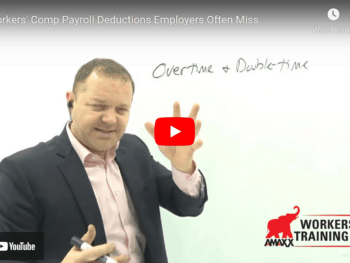There are three factors used to calculate of your workers compensation premium.
- the rate assigned to each payroll classification in your business,
- the total amount of your payroll for each classification,
- and your experience modification factor.
Your workers compensation premium is calculated using the formula:
payroll classification X $100 of payroll X experience modification factor = premium
The only one of these three factors you can reduce without reducing your staffing, is the experience modification factor, often referred to as the “mod” or “experience mod.” The amount of risk assigned to each payroll classification is calculated either by the National Council on Compensation Insurance (NCCI) or your state department of insurance. The amount of payroll is a variable in the premium calculations but the wise employer will staff as needed as the workers compensation premiums should not be the determining factor in your employment of someone.
Click Link to Access Free PDF Download
“Workers’ Comp Claims Review Checklist: 9 Must-Have, Serious-Impact Elements”
The question then becomes “How can we lower our mod?” First you must understand:
- the mod is a numeric representation of the claim history of your business.
- It represents the last three years of claim payments made on your behalf.
- The mod assigned to your business job classifications is a comparisonof your claims record to that of all other employers in your state with the same job classification code(s).
If your claim history and claim payments are higher than average, your mod will be higher than average (1.00) and your workers comp premium will be higher than average. Conversely, if your claim payments and claim history is better than average, your mod will be lower than average and your workers comp premium will be lower than average.
Here are some examples of how this works when your claims history for a job classification code is 20% better and when it is 20% worst than other employers in your state with the same job classification codes.
| Class Code | Payroll | Rate/$100 | Mod | Premium |
| 1234 | $100,000 | $15.00 | .80 | $12,000.00 |
| $100,000 | $15.00 | 1.00 | $15,000.00 | |
| $100,000 | $15.00 | 1.20 | $18,000.00 |
There are several excellent ways the smart employer can reduce their mod. These include:
- A return-to-work program
- A strong safety program
- Never using uninsured subcontractors
- Verifying every employee is properly classified
- Become part of a group rating
1- A Return-to-Work Program
A properly designed return- to-work program will have a major impact on your workers compensation cost. When the injured worker returns to light duty or modified duty work, the cost of the workers comp claim can be greatly reduced.
For example, the injured worker hurts his back. The injured workers comp rate is $500 per week and it will take 20 weeks for the employee to fully recover from the injury. The employee’s supervisor makes the decision that he does not want to be bothered with having an employee on light duty and refuses to take the employee back. The employee will receive $10,000 ($500 x 20) in indemnity benefits that will be included in the mod calculations for the next three premium years.
If the Risk Manager makes the decision by having in place a mandatory return-to-work program, the employee will work light duty during his medical recovery. The $10,000 that would have been paid in indemnity benefits is saved. Also, while the injured employee may not be contributing his full production capability, the employee is still producing some value to the company.
However, the biggest impact of the return-to-work program on the claim history is $10,000 lower and the lower amount of claim payments is utilized in the calculation of the mod for the next three premium years.
2- A Strong Safety Program
A safe worksite is key to reducing your mod. A strong safety program results in fewer accidents and fewer injuries. With fewer injuries, the claim payment history is lower. The lower the claim payment history, the lower the mod and the lower the workers comp insurance premium.
If your safety program is not top-notch, please contact us in regards to our safety kit. You can also hire safety consultants who are trained to identify safety hazards. Implement the recommended safety changes and mandate safety training for all employees.
3- Never Use Uninsured Subcontractors
A common mistake made by employers, especially in the construction fields, is to use subcontractors without confirming they have the proper workers comp insurance. A subcontractor will be covered by your workers comp insurance if the subcontractor is injured while working for you and does not have his own workers comp insurance coverage. This will increase the premium your company will owe at the year-end premium audit and it will increase your company’s mod for the next three policy years. It is well worth the effort to document the workers comp coverage of every subcontractor your company hires.
4- Reviewing Your Classifications
If your clerical person (or linsurance broker) thought it would be easier to classify all your employees as warehouse workers, rather than to take time to properly classify every employee, your workers comp premiums and your mod will be all out of whack. The overall loss experience of your company compared to the claim history of warehouse workers in general could result in your mod being lower or higher than it should be. A careful review of the classifications for every employee type in your company could result in significant savings to your company (or an increase in your premiums, but you avoid committing fraud by declassifying your employees).
5- Become Part of a Group Rating
Many insurers offer group discounts to recognized groups. The effect of the group discounts on your mod is due to most rating groups not your company if your loss experience is higher than average. Normally new companies are not allowed into a group rating as three years of loss experience is needed to calculate the mod. Before joining a group for the benefit of the group mod, be sure the group mod is lower than the mod your company has on its own.
Summary
The only real way to lower your workers compensation premium is to lower your experience modification factor or mod. The best ways to lower your mod include having a mandatory return-to-work program in place, a strong safety program, never using uninsured subcontractors, verifying your classification codes are correct and joining a group rating when it is beneficial to do so.
Author Rebecca Shafer, Attorney/ Consultant, President, Amaxx Risks Solutions, Inc. has worked successfully for 20 years with many industries to reduce Workers’ Compensation costs, including airlines, healthcare, printing/publishing, pharmaceuticals, retail, hospitality and manufacturing. Contact: Info@ReduceYourWorkersComp.com or 860-553-6604.
WC Calculator: http://www.LowerWC.com/calculator.php
TD Calculator: http://www.LowerWC.com/transitional-duty-cost-calculator.php
Do not use this information without independent verification. All state laws vary. You should consult with your insurance broker or agent about workers’ comp issues.
©2010 Amaxx Risk Solutions, Inc. All rights reserved under International Copyright Law.













